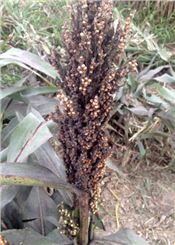|
MSU Experts Help Growers Fight Aphids In Sorghum

This grain sorghum plant in a Mississippi State University plot at the
Delta Research and Extension Center in Stoneville, Mississippi, on
Aug. 28, 2015, shows damage from extremely high populations of sugarcane
aphids with no treatments applied.
Photo by MSU Delta Research and Extension Center/Jeff Gore
STARKVILLE, MISS.
Mississippi State University researchers have spent the last few years on the front lines protecting a $33 million dollar crop in Mississippi.
As grain sorghum production grew, producers had to fight off a new pest.
“The sugarcane aphid problem first showed up in grain sorghum in Louisiana and south Texas in 2012, and growers and scientists were scrambling to save the sorghum. In Mississippi, we saw what was happening and did our best to be pre-emptive,” said Jeff Gore, research entomologist in the Mississippi Agricultural and Forestry Experiment Station and specialist with the MSU Extension Service
Mississippi State scientists along with colleagues across the South helped obtain approval for legal use of one pesticide while establishing a protocol that allowed producers more economical use of a second pesticide.
Gore, along with other university experts, established the effectiveness of using Transform pesticide to control sugarcane aphids in grain sorghum.
“These data were critical because Transform was not labeled for use in grain sorghum,” Gore said. “We presented our findings to the Environmental Protection Agency, and the data were the basis for filing for a Section 18 exemption, under which the EPA allows unregistered use of a pesticide for a limited time if an emergency condition exists.”
Gore said the emergency exemption helped Mississippi growers because they had a way to defend their crops against sugarcane aphids when the pests hit the state.
“Some states did not apply for the emergency exemption until they had sugarcane aphids in grain sorghum, and growers had to wait several days before making a spray,” he said.
Next, researchers sought other pesticides to help control the sugarcane aphids in grain sorghum. They found that the pesticide Sivanto proved effective. The problem with Sivanto, however, was that the recommended minimum application rate on the label was too expensive for grain sorghum producers to afford.
Entomologists across the Midsouth conducted research to determine that half the minimum rate would provide good control of sugarcane aphids in grain sorghum. They then presented the data to the manufacturer, which led to a reduced rate addendum, called a “2ee,” for grain sorghum producers to use Sivanto pesticide to control sugarcane aphids.
“Pesticide applications include a minimum use rate, which guarantees effectiveness as long as producers apply at least the minimum amount of product recommended by the manufacturer,” explained Gore. “The 2ee provided assurance that the company would guarantee the effectiveness of the product at the reduced rate, making application of Sivanto affordable.”
So far, Gore and other MSU entomologists have been successful in helping grain sorghum producers fight off the sugarcane aphid.
Extension entomologist Angus Catchot said treatment options may change next year.
“In September, a U.S. appeals court in California ruled that federal regulators made an error in registering Dow’s Transform without sufficient pollinator toxicity data. That may prevent us from using it next year, but we will see how this situation plays out,” Catchot said. “This would leave us with one product to combat sugarcane aphids in grain sorghum, which potentially raises concerns about the development of resistance to the insecticide.”
Since the pest came to Mississippi, the MSU entomology team has been diligent in researching and sharing their findings and recommendations with grain sorghum producers. Gore and Catchot advise a graduate student in the MSU College of Agriculture and Life Sciences, who is dedicated to studying sugarcane aphids in grain sorghum.
According to the U.S. Department of Agriculture’s preliminary 2015 harvest data, the crop may beat grain sorghum records set in 2014. Acres harvested in 2015 total 115,000, up from the 105,000 harvested in 2014. Yield per acre is 89 bushels, up from the 2014 yield of 80 bushels. Estimated total production is more than 10.2 million bushels, up 22 percent from the 8.4 million bushels harvested in 2014.
As sorghum production continues to increase, MSU personnel remain vigilant to make sure producers have the tools and information they need to fight the sugarcane aphid.
For the latest information on the harvest in Mississippi, visit http://www.mississippi-crops.com. Farmers considering grain sorghum as a crop should consult the Mississippi Agricultural and Forestry Experiment Station’s variety trial website at http://mafes.msstate.edu/variety-trials/. ∆
|
|